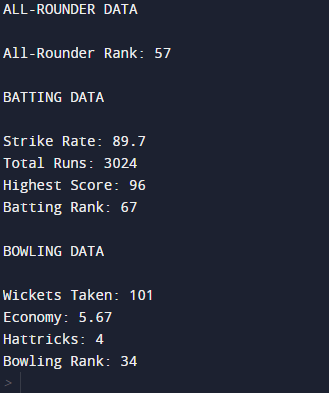Implementing Multiple-Inheritance using Python
This tutorial will show you how to implement Multiple-Inheritance in Python, the syntax, program along with an explanation.
Prerequisites: Basic idea of Multiple-Inheritance and implementation of classes in Python (refer: Classes and Objects in Python).
Also read the previous tutorial: Introduction to Multiple Inheritance.
The Syntax for Multiple Inheritance
The basic format/syntax for multiple-inheritance in Python is as follows:
class Base_1: #Base Class 1
pass
class Base_2: #Base Class 2
pass
class Derived(Base_1,Base_2): #Class that derives from both the above base classes
pass
The above code contains two base classes. Both of them may have their member functions and data members. The third class, which derives from both these base classes can make use of their data members as well as member functions, as long as they are not private to the respective base classes.
Sample Program for Multiple Inheritance
Now, we take up an example to make things more clear. Consider cricket players. There are broadly three categories – batsman, bowlers, and all-rounders. All-rounders have statistical data records about both batting as well as bowling. In other words, they inherit the characteristics of both categories – batsman and bowlers.
Section- wise explanation
Let us define the base classes
class Batsman:
def __init__(self):
self.strike_rate = 0.0
self.total_runs = 0
self.highest_score = 0
self.batting_rank = 0
def get_bat(self,sr,tr,hs,br):
self.strike_rate = sr
self.total_runs = tr
self.highest_score = hs
self.batting_rank = br
def disp_bat(self):
print("Strike Rate:",self.strike_rate)
print("Total Runs:",self.total_runs)
print("Highest Score:",self.highest_score)
print("Batting Rank:",self.batting_rank)This is the Batsman class, which contains identifiers for some of the details about a batsman and two member functions: get_bat to get the details of an object of batsman class, and disp_bat to display the details of an object of the batsman class.
In the same way, we define another base class – Bowler with details and functions relating to a bowler.
class Bowler:
def __init__(self):
self.wickets_taken = 0
self.economy = 0.0
self.hattricks = 0
self.bowling_rank = 0
def get_bowl(self,wt,ec,ht,bor):
self.wickets_taken = wt
self.economy = wc
self.hattricks = ht
self.bowling_rank = bor
def disp_bowl(self):
print("Wickets Taken:",self.wickets_taken)
print("Economy:",self.economy)
print("Hattricks:",self.hattricks)
print("Bowling Rank:",self.bowling_rank)So, now that we have both our base classes, we define the derived class
class AllRounder(Batsman,Bowler):
def __init__(self):
Batsman.__init__(self)
Bowler.__init__(self)
self.allrounder_rank = 0
def get_all(self,sr,tr,hs,br,wt,ec,ht,bor,ar):
Batsman.get_bat(self,sr,tr,hs,br)
Bowler.get_bowl(self,wt,ec,ht,bor)
self.allrounder_rank =
def disp_all(self):
self.disp_bat()
self.disp_bowl()
print("All Rounder Rank:",self.allrounder_rank)As per the syntax, the names of the base classes have been mentioned within parentheses, soon after the name of the class in the class header line.
In this class, under the _init_() function, we have explicitly called the _init_() functions of the base classes, so that whenever an object of class -AllRounder is initialized, the instance variables of the base classes for the object will also get initialized. Suppose we create an object -obj of AllRounder, the _init_ method/function of class AllRounder will be called implicitly, following which, the inherited data members of obj from Batsman and Bowler classes will be initialized when the explicit calls are made to their _init_() functions.
After that, we add an allrounder_rank data member. This is specific only to objects of AllRounder class and holds no meaning for objects of Batsman or Bowler class. In this way, we can add specific features to the derived class without disturbing the base classes.
Similarly, in the geta_all and disp_all functions, assign/display data values that belong to the base classes by calling the respective inherited member functions, as well as, the ones that are specified to derived AllRounder class.
Complete Program
Let us know put together the pieces and create an object of the AllRounder class.
class Batsman:
def __init__(self):
self.strike_rate = 0.0
self.total_runs = 0
self.highest_score = 0
self.batting_rank = 0
def get_bat(self,sr,tr,hs,br):
self.strike_rate = sr
self.total_runs = tr
self.highest_score = hs
self.batting_rank = br
def disp_bat(self):
print("\nBATTING DATA\n")
print("Strike Rate:",self.strike_rate)
print("Total Runs:",self.total_runs)
print("Highest Score:",self.highest_score)
print("Batting Rank:",self.batting_rank)
class Bowler:
def __init__(self):
self.wickets_taken = 0
self.economy = 0.0
self.hattricks = 0
self.bowling_rank = 0
def get_bowl(self,wt,ec,ht,bor):
self.wickets_taken = wt
self.economy = ec
self.hattricks = ht
self.bowling_rank = bor
def disp_bowl(self):
print("\nBOWLING DATA\n")
print("Wickets Taken:",self.wickets_taken)
print("Economy:",self.economy)
print("Hattricks:",self.hattricks)
print("Bowling Rank:",self.bowling_rank)
class AllRounder(Batsman,Bowler):
def __init__(self):
Batsman.__init__(self)
Bowler.__init__(self)
self.allrounder_rank = 0
def get_all(self,sr,tr,hs,br,wt,ec,ht,bor,ar):
Batsman.get_bat(self,sr,tr,hs,br)
Bowler.get_bowl(self,wt,ec,ht,bor)
self.allrounder_rank = ar
def disp_all(self):
print("\nALL-ROUNDER DATA")
print("\nAll-Rounder Rank:",self.allrounder_rank)
self.disp_bat()
self.disp_bowl()
player1 = AllRounder()
player1.get_all(89.7,3024,96,67,101,5.67,4,34,57)
player1.disp_all()In the main section, we declare player1 as an object of the AllRounder class. We then accept all data values for player1 through the get_all function. Redistribute them to respective base classes(see the function definition). Finally, we display the data for the player1 object.
The output is as follows:

the program is show the error please correct the error
Hello Navina,
The code seems to be working, as verified with an online compiler.
Please ensure that you are using Python 2.7.x to run the code.
Thanks!